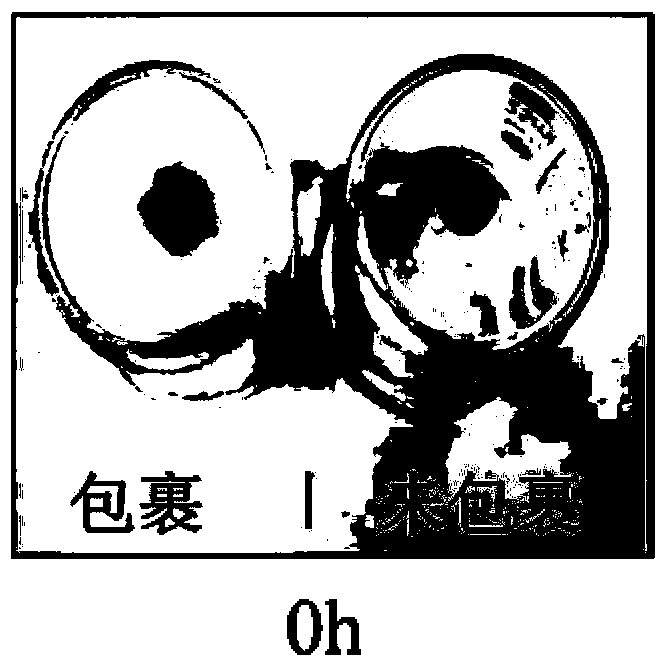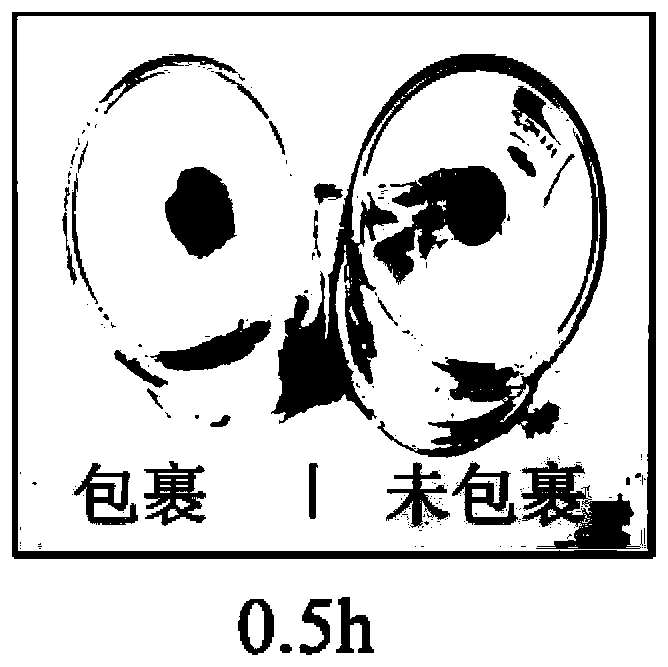Temporary sealing and protecting method for cultural relics at archaeological excavation site
A temporary and cultural relic technology, applied in the direction of coating, etc., can solve the problems of increasing the cost of archaeological and cultural relics protection, cyclododecane is expensive and difficult to degrade, and achieves simple and effective protection, good sealing effect and easy removal Effect
- Summary
- Abstract
- Description
- Claims
- Application Information
AI Technical Summary
Problems solved by technology
Method used
Image
Examples
Embodiment 1
[0036] In this embodiment, menthol is used to simulate the temporary sealing of water-sensitive samples by melting method. Put menthol in a glass beaker, heat and melt in a water bath at 60°C, and quickly apply the melt directly on the surface of the sample with a brush or dropper, and pay attention to ensure that the surface of the simulated sample is covered during the coating process. full coverage. After the material penetrates into the surface of the sample and cools and solidifies, the temporary sealing of the water-sensitive sample is realized. In this embodiment, the thickness of the sealing layer is about 0.3 cm, and the amount of the sealing material and the thickness of the sealing layer are determined by the permeability of the cultural relics to be treated. In this embodiment, after the temporarily sealed sample is placed in an open environment (room temperature 25°C, relative humidity 60%) for a week, the moisture content in the simulated sample changes less tha...
Embodiment 2
[0038] In this example, menthol is used to simulate the temporary sealing of water-sensitive samples. The difference from Example 1 is that 3g of menthol is dissolved in 1g of organic solvent and then placed in a spray can and applied to cultural relics by spraying. Dissolve menthol in an organic solvent and put it in a spray can, and spray it directly on the surface of the sample by spraying, and pay attention to ensure that the surface of the simulated sample is completely covered during the spraying process. After the organic solvent volatilizes and the material solidifies, the temporary sealing of the water-sensitive sample is realized. In this embodiment, the thickness of the sealing layer is about 0.1 cm. In this embodiment, the organic solvent used is propane. In this embodiment, the process parameters used are the same as those in Embodiment 1. In this embodiment, after the temporarily sealed sample is placed in an open environment (room temperature 25°C, relative hum...
Embodiment 3
[0040] In this embodiment, menthyl lactate is applied to simulate the temporary sealing of samples sensitive to oxygen by adopting a melting method. Put menthyl lactate in a glass beaker, heat and melt in a water bath at 60°C, and quickly spray the melt directly on the surface of the sample with a brush or dropper, paying attention to ensure that the surface of the simulated sample is completely covered during the coating process. After the material is cooled and solidified, the temporary protection of the oxygen-sensitive sample is realized. In this embodiment, the thickness of the sealing layer is about 0.3 cm. In this embodiment, the process parameters used are the same as those in Embodiment 1. In this embodiment, the temporarily sealed sample and the blank sample were placed in a ventilated environment for 30 days, the sealed simulated sample remained unchanged, and the blank sample was oxidized by oxygen in the air. Therefore, the temporary sealing material can play a r...
PUM
| Property | Measurement | Unit |
|---|---|---|
| thickness | aaaaa | aaaaa |
| thickness | aaaaa | aaaaa |
| thickness | aaaaa | aaaaa |
Abstract
Description
Claims
Application Information
 Login to View More
Login to View More - R&D
- Intellectual Property
- Life Sciences
- Materials
- Tech Scout
- Unparalleled Data Quality
- Higher Quality Content
- 60% Fewer Hallucinations
Browse by: Latest US Patents, China's latest patents, Technical Efficacy Thesaurus, Application Domain, Technology Topic, Popular Technical Reports.
© 2025 PatSnap. All rights reserved.Legal|Privacy policy|Modern Slavery Act Transparency Statement|Sitemap|About US| Contact US: help@patsnap.com



